Strategic Analysis of Mergers and Acquisitions: A Comprehensive Report
VerifiedAdded on 2023/06/04
|13
|3557
|494
Report
AI Summary
This report provides an in-depth analysis of the challenges and complexities associated with mergers and acquisitions (M&A). The report examines a case study involving the merger of DeWaal Pharmaceuticals and BioHealth, highlighting issues such as executive decision-making, cultural disparities, human resource management, and the importance of strategic planning. It discusses the problems arising from conflicting leadership styles, employee concerns about job security, and the failure to address cultural differences effectively. The report emphasizes the need for a well-defined integration strategy, effective communication, and the use of external consultants to ensure a fair and transparent selection process for key executives. The recommendations include outsourcing the appraisal process, developing communication strategies, and addressing employee concerns proactively to maximize shareholder value and minimize the risks associated with mergers. The report also highlights the importance of data-driven decision-making and the need for a clear plan to retain key talent during the integration process.
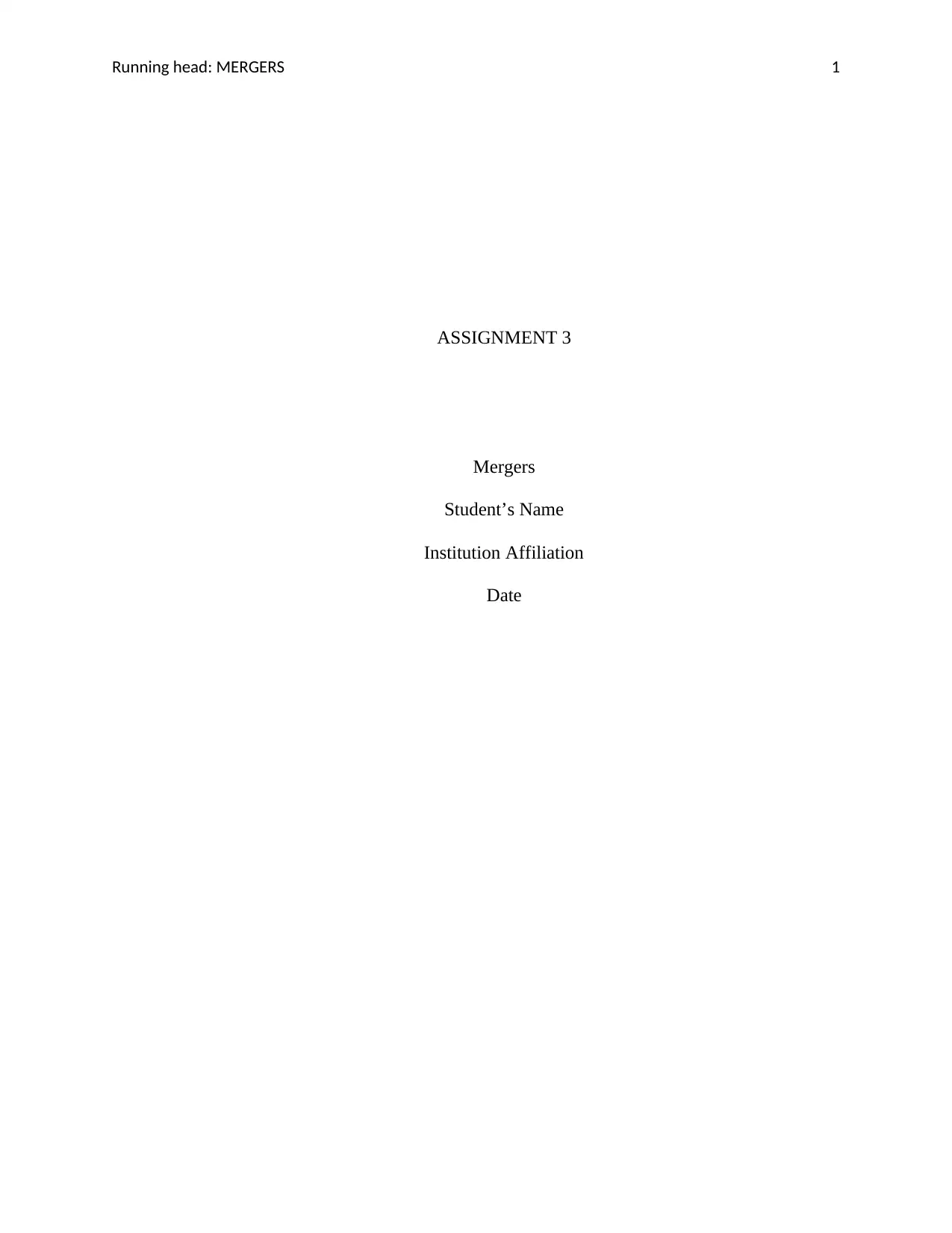
Running head: MERGERS 1
ASSIGNMENT 3
Mergers
Student’s Name
Institution Affiliation
Date
ASSIGNMENT 3
Mergers
Student’s Name
Institution Affiliation
Date
Paraphrase This Document
Need a fresh take? Get an instant paraphrase of this document with our AI Paraphraser
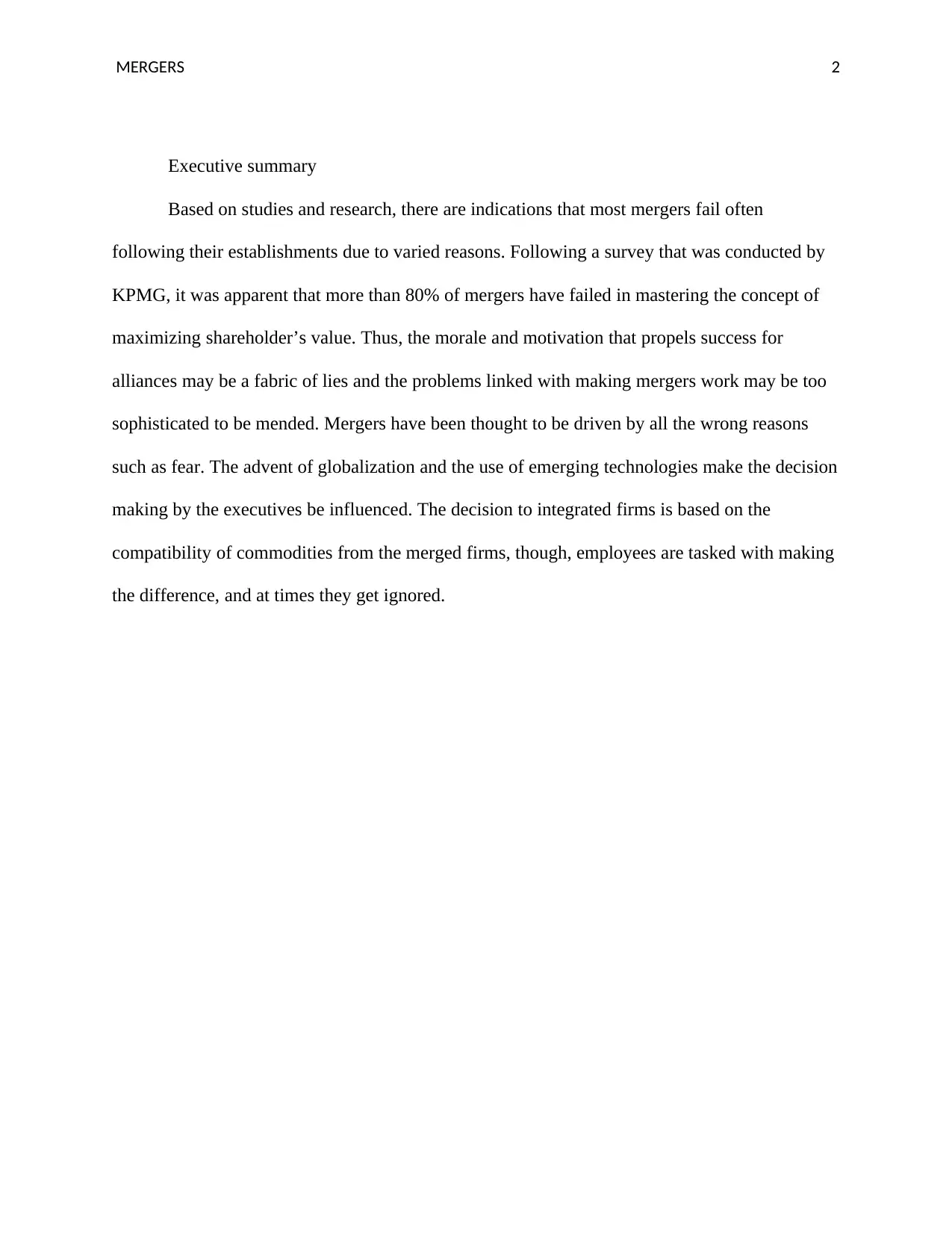
MERGERS 2
Executive summary
Based on studies and research, there are indications that most mergers fail often
following their establishments due to varied reasons. Following a survey that was conducted by
KPMG, it was apparent that more than 80% of mergers have failed in mastering the concept of
maximizing shareholder’s value. Thus, the morale and motivation that propels success for
alliances may be a fabric of lies and the problems linked with making mergers work may be too
sophisticated to be mended. Mergers have been thought to be driven by all the wrong reasons
such as fear. The advent of globalization and the use of emerging technologies make the decision
making by the executives be influenced. The decision to integrated firms is based on the
compatibility of commodities from the merged firms, though, employees are tasked with making
the difference, and at times they get ignored.
Executive summary
Based on studies and research, there are indications that most mergers fail often
following their establishments due to varied reasons. Following a survey that was conducted by
KPMG, it was apparent that more than 80% of mergers have failed in mastering the concept of
maximizing shareholder’s value. Thus, the morale and motivation that propels success for
alliances may be a fabric of lies and the problems linked with making mergers work may be too
sophisticated to be mended. Mergers have been thought to be driven by all the wrong reasons
such as fear. The advent of globalization and the use of emerging technologies make the decision
making by the executives be influenced. The decision to integrated firms is based on the
compatibility of commodities from the merged firms, though, employees are tasked with making
the difference, and at times they get ignored.
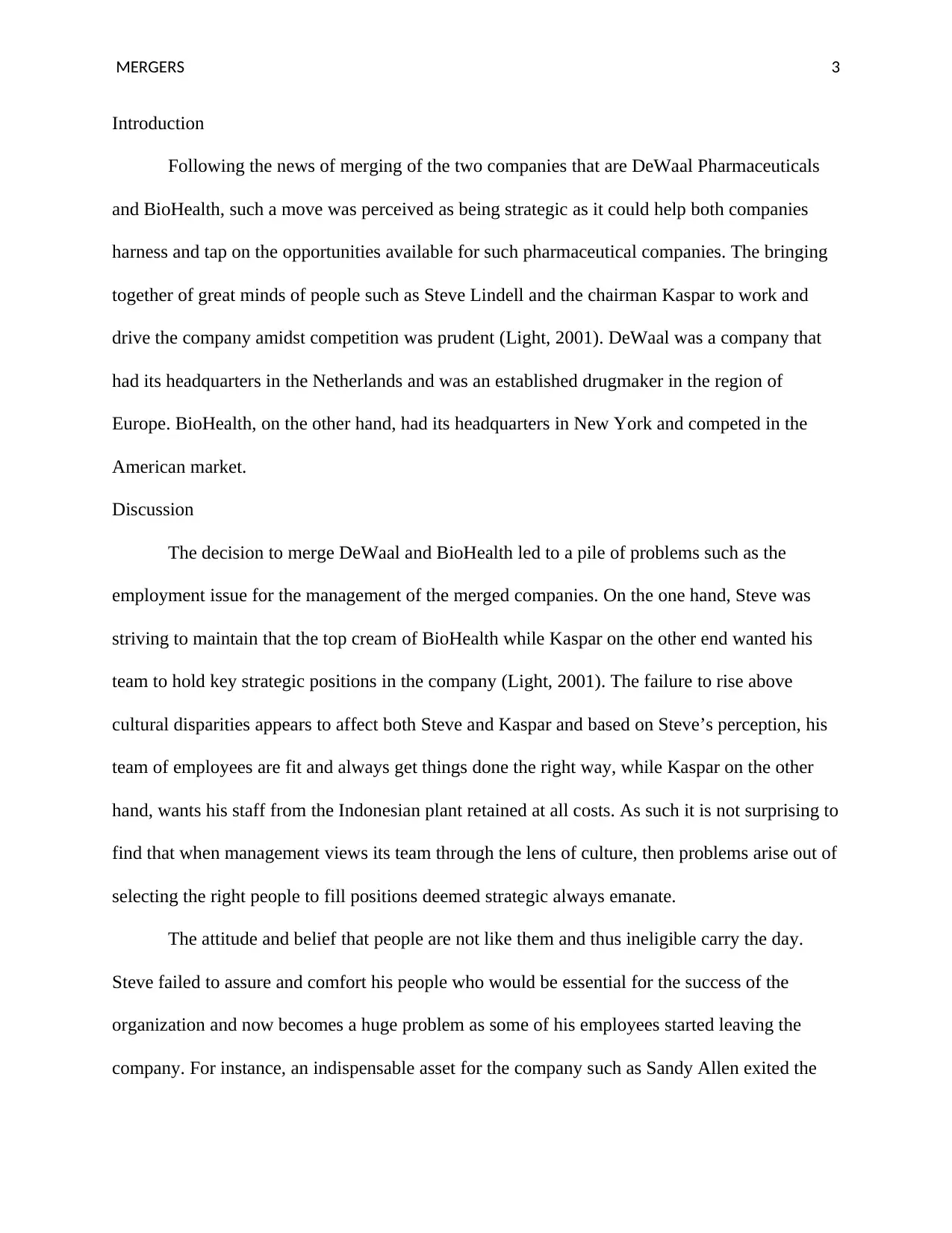
MERGERS 3
Introduction
Following the news of merging of the two companies that are DeWaal Pharmaceuticals
and BioHealth, such a move was perceived as being strategic as it could help both companies
harness and tap on the opportunities available for such pharmaceutical companies. The bringing
together of great minds of people such as Steve Lindell and the chairman Kaspar to work and
drive the company amidst competition was prudent (Light, 2001). DeWaal was a company that
had its headquarters in the Netherlands and was an established drugmaker in the region of
Europe. BioHealth, on the other hand, had its headquarters in New York and competed in the
American market.
Discussion
The decision to merge DeWaal and BioHealth led to a pile of problems such as the
employment issue for the management of the merged companies. On the one hand, Steve was
striving to maintain that the top cream of BioHealth while Kaspar on the other end wanted his
team to hold key strategic positions in the company (Light, 2001). The failure to rise above
cultural disparities appears to affect both Steve and Kaspar and based on Steve’s perception, his
team of employees are fit and always get things done the right way, while Kaspar on the other
hand, wants his staff from the Indonesian plant retained at all costs. As such it is not surprising to
find that when management views its team through the lens of culture, then problems arise out of
selecting the right people to fill positions deemed strategic always emanate.
The attitude and belief that people are not like them and thus ineligible carry the day.
Steve failed to assure and comfort his people who would be essential for the success of the
organization and now becomes a huge problem as some of his employees started leaving the
company. For instance, an indispensable asset for the company such as Sandy Allen exited the
Introduction
Following the news of merging of the two companies that are DeWaal Pharmaceuticals
and BioHealth, such a move was perceived as being strategic as it could help both companies
harness and tap on the opportunities available for such pharmaceutical companies. The bringing
together of great minds of people such as Steve Lindell and the chairman Kaspar to work and
drive the company amidst competition was prudent (Light, 2001). DeWaal was a company that
had its headquarters in the Netherlands and was an established drugmaker in the region of
Europe. BioHealth, on the other hand, had its headquarters in New York and competed in the
American market.
Discussion
The decision to merge DeWaal and BioHealth led to a pile of problems such as the
employment issue for the management of the merged companies. On the one hand, Steve was
striving to maintain that the top cream of BioHealth while Kaspar on the other end wanted his
team to hold key strategic positions in the company (Light, 2001). The failure to rise above
cultural disparities appears to affect both Steve and Kaspar and based on Steve’s perception, his
team of employees are fit and always get things done the right way, while Kaspar on the other
hand, wants his staff from the Indonesian plant retained at all costs. As such it is not surprising to
find that when management views its team through the lens of culture, then problems arise out of
selecting the right people to fill positions deemed strategic always emanate.
The attitude and belief that people are not like them and thus ineligible carry the day.
Steve failed to assure and comfort his people who would be essential for the success of the
organization and now becomes a huge problem as some of his employees started leaving the
company. For instance, an indispensable asset for the company such as Sandy Allen exited the
⊘ This is a preview!⊘
Do you want full access?
Subscribe today to unlock all pages.

Trusted by 1+ million students worldwide
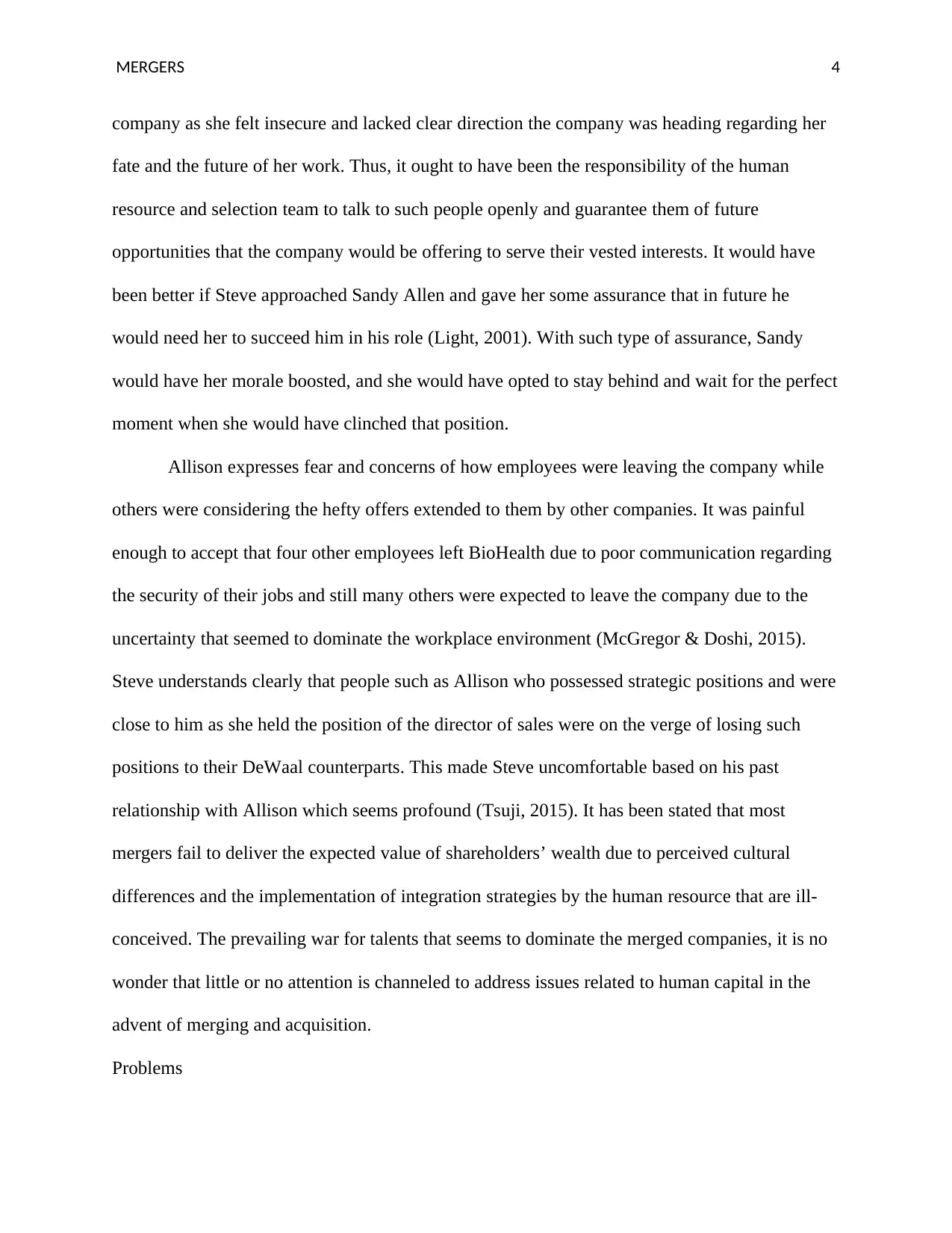
MERGERS 4
company as she felt insecure and lacked clear direction the company was heading regarding her
fate and the future of her work. Thus, it ought to have been the responsibility of the human
resource and selection team to talk to such people openly and guarantee them of future
opportunities that the company would be offering to serve their vested interests. It would have
been better if Steve approached Sandy Allen and gave her some assurance that in future he
would need her to succeed him in his role (Light, 2001). With such type of assurance, Sandy
would have her morale boosted, and she would have opted to stay behind and wait for the perfect
moment when she would have clinched that position.
Allison expresses fear and concerns of how employees were leaving the company while
others were considering the hefty offers extended to them by other companies. It was painful
enough to accept that four other employees left BioHealth due to poor communication regarding
the security of their jobs and still many others were expected to leave the company due to the
uncertainty that seemed to dominate the workplace environment (McGregor & Doshi, 2015).
Steve understands clearly that people such as Allison who possessed strategic positions and were
close to him as she held the position of the director of sales were on the verge of losing such
positions to their DeWaal counterparts. This made Steve uncomfortable based on his past
relationship with Allison which seems profound (Tsuji, 2015). It has been stated that most
mergers fail to deliver the expected value of shareholders’ wealth due to perceived cultural
differences and the implementation of integration strategies by the human resource that are ill-
conceived. The prevailing war for talents that seems to dominate the merged companies, it is no
wonder that little or no attention is channeled to address issues related to human capital in the
advent of merging and acquisition.
Problems
company as she felt insecure and lacked clear direction the company was heading regarding her
fate and the future of her work. Thus, it ought to have been the responsibility of the human
resource and selection team to talk to such people openly and guarantee them of future
opportunities that the company would be offering to serve their vested interests. It would have
been better if Steve approached Sandy Allen and gave her some assurance that in future he
would need her to succeed him in his role (Light, 2001). With such type of assurance, Sandy
would have her morale boosted, and she would have opted to stay behind and wait for the perfect
moment when she would have clinched that position.
Allison expresses fear and concerns of how employees were leaving the company while
others were considering the hefty offers extended to them by other companies. It was painful
enough to accept that four other employees left BioHealth due to poor communication regarding
the security of their jobs and still many others were expected to leave the company due to the
uncertainty that seemed to dominate the workplace environment (McGregor & Doshi, 2015).
Steve understands clearly that people such as Allison who possessed strategic positions and were
close to him as she held the position of the director of sales were on the verge of losing such
positions to their DeWaal counterparts. This made Steve uncomfortable based on his past
relationship with Allison which seems profound (Tsuji, 2015). It has been stated that most
mergers fail to deliver the expected value of shareholders’ wealth due to perceived cultural
differences and the implementation of integration strategies by the human resource that are ill-
conceived. The prevailing war for talents that seems to dominate the merged companies, it is no
wonder that little or no attention is channeled to address issues related to human capital in the
advent of merging and acquisition.
Problems
Paraphrase This Document
Need a fresh take? Get an instant paraphrase of this document with our AI Paraphraser
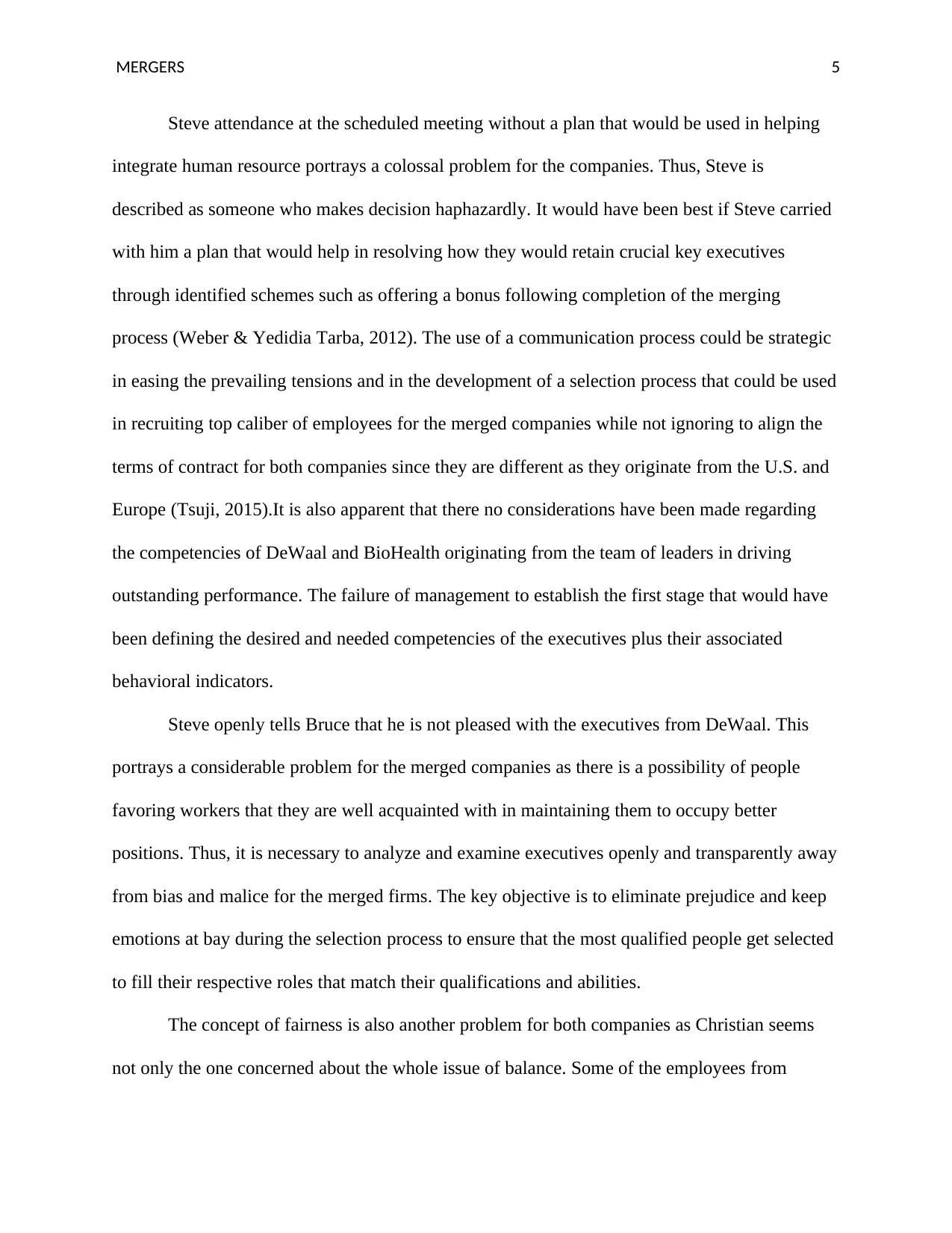
MERGERS 5
Steve attendance at the scheduled meeting without a plan that would be used in helping
integrate human resource portrays a colossal problem for the companies. Thus, Steve is
described as someone who makes decision haphazardly. It would have been best if Steve carried
with him a plan that would help in resolving how they would retain crucial key executives
through identified schemes such as offering a bonus following completion of the merging
process (Weber & Yedidia Tarba, 2012). The use of a communication process could be strategic
in easing the prevailing tensions and in the development of a selection process that could be used
in recruiting top caliber of employees for the merged companies while not ignoring to align the
terms of contract for both companies since they are different as they originate from the U.S. and
Europe (Tsuji, 2015).It is also apparent that there no considerations have been made regarding
the competencies of DeWaal and BioHealth originating from the team of leaders in driving
outstanding performance. The failure of management to establish the first stage that would have
been defining the desired and needed competencies of the executives plus their associated
behavioral indicators.
Steve openly tells Bruce that he is not pleased with the executives from DeWaal. This
portrays a considerable problem for the merged companies as there is a possibility of people
favoring workers that they are well acquainted with in maintaining them to occupy better
positions. Thus, it is necessary to analyze and examine executives openly and transparently away
from bias and malice for the merged firms. The key objective is to eliminate prejudice and keep
emotions at bay during the selection process to ensure that the most qualified people get selected
to fill their respective roles that match their qualifications and abilities.
The concept of fairness is also another problem for both companies as Christian seems
not only the one concerned about the whole issue of balance. Some of the employees from
Steve attendance at the scheduled meeting without a plan that would be used in helping
integrate human resource portrays a colossal problem for the companies. Thus, Steve is
described as someone who makes decision haphazardly. It would have been best if Steve carried
with him a plan that would help in resolving how they would retain crucial key executives
through identified schemes such as offering a bonus following completion of the merging
process (Weber & Yedidia Tarba, 2012). The use of a communication process could be strategic
in easing the prevailing tensions and in the development of a selection process that could be used
in recruiting top caliber of employees for the merged companies while not ignoring to align the
terms of contract for both companies since they are different as they originate from the U.S. and
Europe (Tsuji, 2015).It is also apparent that there no considerations have been made regarding
the competencies of DeWaal and BioHealth originating from the team of leaders in driving
outstanding performance. The failure of management to establish the first stage that would have
been defining the desired and needed competencies of the executives plus their associated
behavioral indicators.
Steve openly tells Bruce that he is not pleased with the executives from DeWaal. This
portrays a considerable problem for the merged companies as there is a possibility of people
favoring workers that they are well acquainted with in maintaining them to occupy better
positions. Thus, it is necessary to analyze and examine executives openly and transparently away
from bias and malice for the merged firms. The key objective is to eliminate prejudice and keep
emotions at bay during the selection process to ensure that the most qualified people get selected
to fill their respective roles that match their qualifications and abilities.
The concept of fairness is also another problem for both companies as Christian seems
not only the one concerned about the whole issue of balance. Some of the employees from
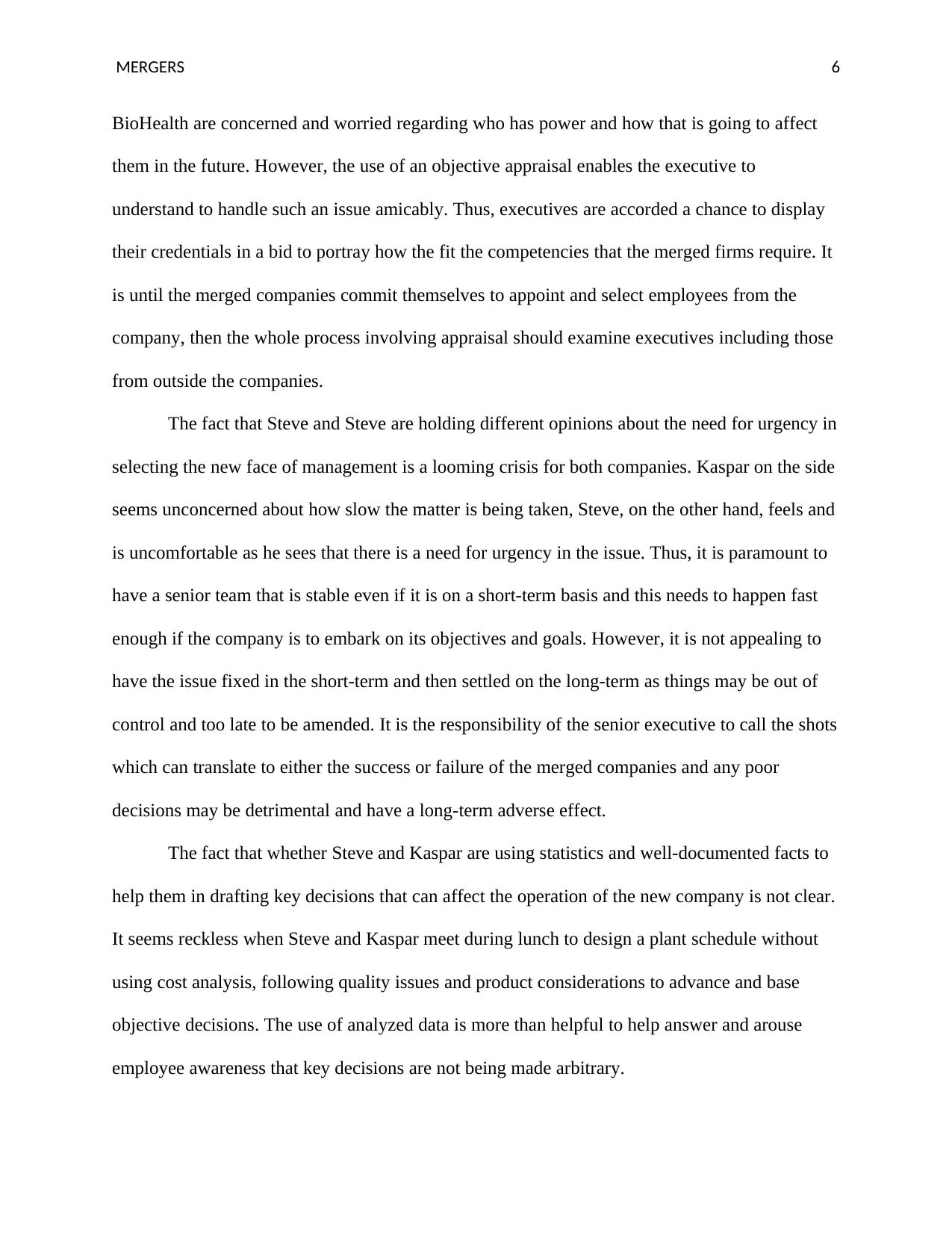
MERGERS 6
BioHealth are concerned and worried regarding who has power and how that is going to affect
them in the future. However, the use of an objective appraisal enables the executive to
understand to handle such an issue amicably. Thus, executives are accorded a chance to display
their credentials in a bid to portray how the fit the competencies that the merged firms require. It
is until the merged companies commit themselves to appoint and select employees from the
company, then the whole process involving appraisal should examine executives including those
from outside the companies.
The fact that Steve and Steve are holding different opinions about the need for urgency in
selecting the new face of management is a looming crisis for both companies. Kaspar on the side
seems unconcerned about how slow the matter is being taken, Steve, on the other hand, feels and
is uncomfortable as he sees that there is a need for urgency in the issue. Thus, it is paramount to
have a senior team that is stable even if it is on a short-term basis and this needs to happen fast
enough if the company is to embark on its objectives and goals. However, it is not appealing to
have the issue fixed in the short-term and then settled on the long-term as things may be out of
control and too late to be amended. It is the responsibility of the senior executive to call the shots
which can translate to either the success or failure of the merged companies and any poor
decisions may be detrimental and have a long-term adverse effect.
The fact that whether Steve and Kaspar are using statistics and well-documented facts to
help them in drafting key decisions that can affect the operation of the new company is not clear.
It seems reckless when Steve and Kaspar meet during lunch to design a plant schedule without
using cost analysis, following quality issues and product considerations to advance and base
objective decisions. The use of analyzed data is more than helpful to help answer and arouse
employee awareness that key decisions are not being made arbitrary.
BioHealth are concerned and worried regarding who has power and how that is going to affect
them in the future. However, the use of an objective appraisal enables the executive to
understand to handle such an issue amicably. Thus, executives are accorded a chance to display
their credentials in a bid to portray how the fit the competencies that the merged firms require. It
is until the merged companies commit themselves to appoint and select employees from the
company, then the whole process involving appraisal should examine executives including those
from outside the companies.
The fact that Steve and Steve are holding different opinions about the need for urgency in
selecting the new face of management is a looming crisis for both companies. Kaspar on the side
seems unconcerned about how slow the matter is being taken, Steve, on the other hand, feels and
is uncomfortable as he sees that there is a need for urgency in the issue. Thus, it is paramount to
have a senior team that is stable even if it is on a short-term basis and this needs to happen fast
enough if the company is to embark on its objectives and goals. However, it is not appealing to
have the issue fixed in the short-term and then settled on the long-term as things may be out of
control and too late to be amended. It is the responsibility of the senior executive to call the shots
which can translate to either the success or failure of the merged companies and any poor
decisions may be detrimental and have a long-term adverse effect.
The fact that whether Steve and Kaspar are using statistics and well-documented facts to
help them in drafting key decisions that can affect the operation of the new company is not clear.
It seems reckless when Steve and Kaspar meet during lunch to design a plant schedule without
using cost analysis, following quality issues and product considerations to advance and base
objective decisions. The use of analyzed data is more than helpful to help answer and arouse
employee awareness that key decisions are not being made arbitrary.
⊘ This is a preview!⊘
Do you want full access?
Subscribe today to unlock all pages.

Trusted by 1+ million students worldwide
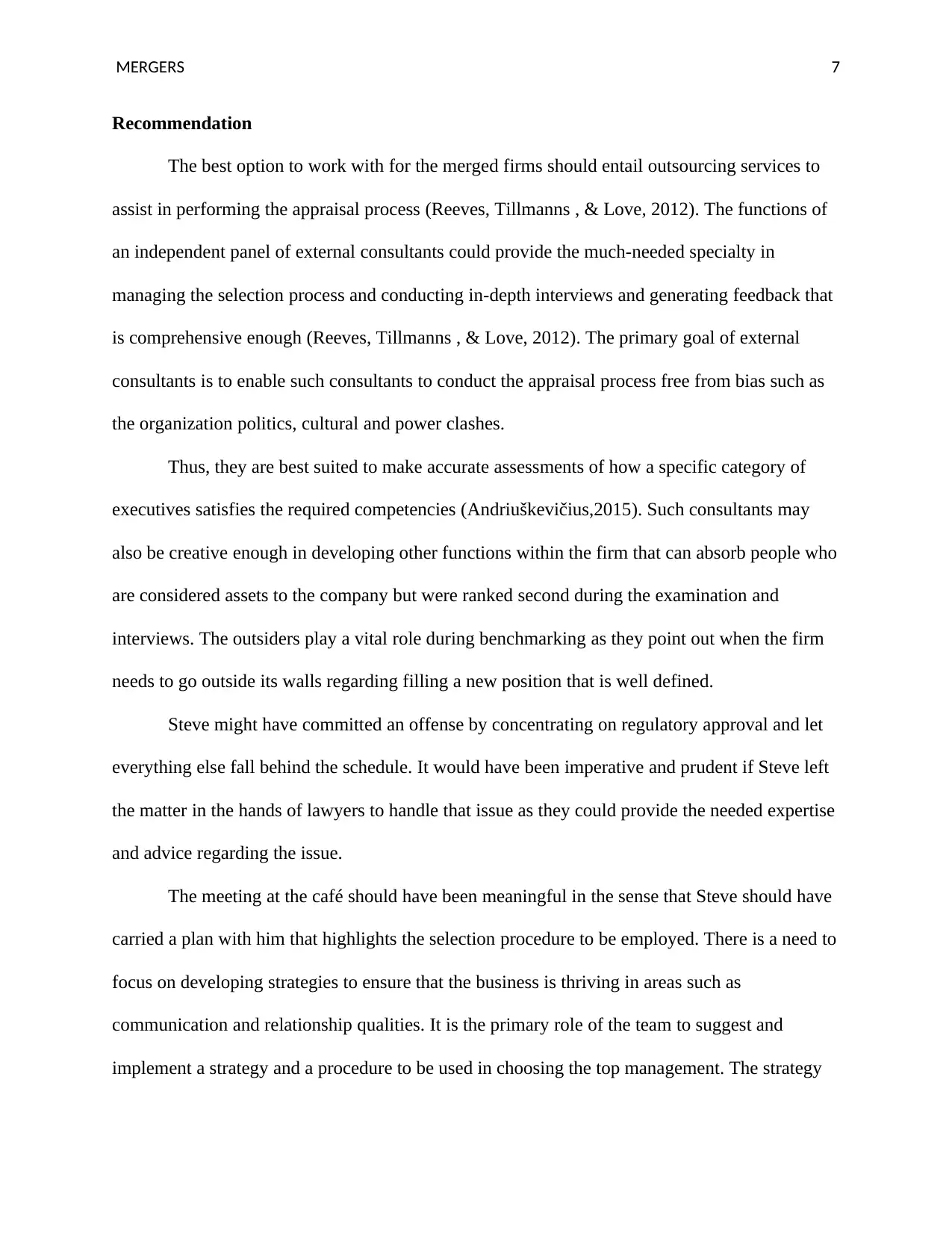
MERGERS 7
Recommendation
The best option to work with for the merged firms should entail outsourcing services to
assist in performing the appraisal process (Reeves, Tillmanns , & Love, 2012). The functions of
an independent panel of external consultants could provide the much-needed specialty in
managing the selection process and conducting in-depth interviews and generating feedback that
is comprehensive enough (Reeves, Tillmanns , & Love, 2012). The primary goal of external
consultants is to enable such consultants to conduct the appraisal process free from bias such as
the organization politics, cultural and power clashes.
Thus, they are best suited to make accurate assessments of how a specific category of
executives satisfies the required competencies (Andriuškevičius,2015). Such consultants may
also be creative enough in developing other functions within the firm that can absorb people who
are considered assets to the company but were ranked second during the examination and
interviews. The outsiders play a vital role during benchmarking as they point out when the firm
needs to go outside its walls regarding filling a new position that is well defined.
Steve might have committed an offense by concentrating on regulatory approval and let
everything else fall behind the schedule. It would have been imperative and prudent if Steve left
the matter in the hands of lawyers to handle that issue as they could provide the needed expertise
and advice regarding the issue.
The meeting at the café should have been meaningful in the sense that Steve should have
carried a plan with him that highlights the selection procedure to be employed. There is a need to
focus on developing strategies to ensure that the business is thriving in areas such as
communication and relationship qualities. It is the primary role of the team to suggest and
implement a strategy and a procedure to be used in choosing the top management. The strategy
Recommendation
The best option to work with for the merged firms should entail outsourcing services to
assist in performing the appraisal process (Reeves, Tillmanns , & Love, 2012). The functions of
an independent panel of external consultants could provide the much-needed specialty in
managing the selection process and conducting in-depth interviews and generating feedback that
is comprehensive enough (Reeves, Tillmanns , & Love, 2012). The primary goal of external
consultants is to enable such consultants to conduct the appraisal process free from bias such as
the organization politics, cultural and power clashes.
Thus, they are best suited to make accurate assessments of how a specific category of
executives satisfies the required competencies (Andriuškevičius,2015). Such consultants may
also be creative enough in developing other functions within the firm that can absorb people who
are considered assets to the company but were ranked second during the examination and
interviews. The outsiders play a vital role during benchmarking as they point out when the firm
needs to go outside its walls regarding filling a new position that is well defined.
Steve might have committed an offense by concentrating on regulatory approval and let
everything else fall behind the schedule. It would have been imperative and prudent if Steve left
the matter in the hands of lawyers to handle that issue as they could provide the needed expertise
and advice regarding the issue.
The meeting at the café should have been meaningful in the sense that Steve should have
carried a plan with him that highlights the selection procedure to be employed. There is a need to
focus on developing strategies to ensure that the business is thriving in areas such as
communication and relationship qualities. It is the primary role of the team to suggest and
implement a strategy and a procedure to be used in choosing the top management. The strategy
Paraphrase This Document
Need a fresh take? Get an instant paraphrase of this document with our AI Paraphraser
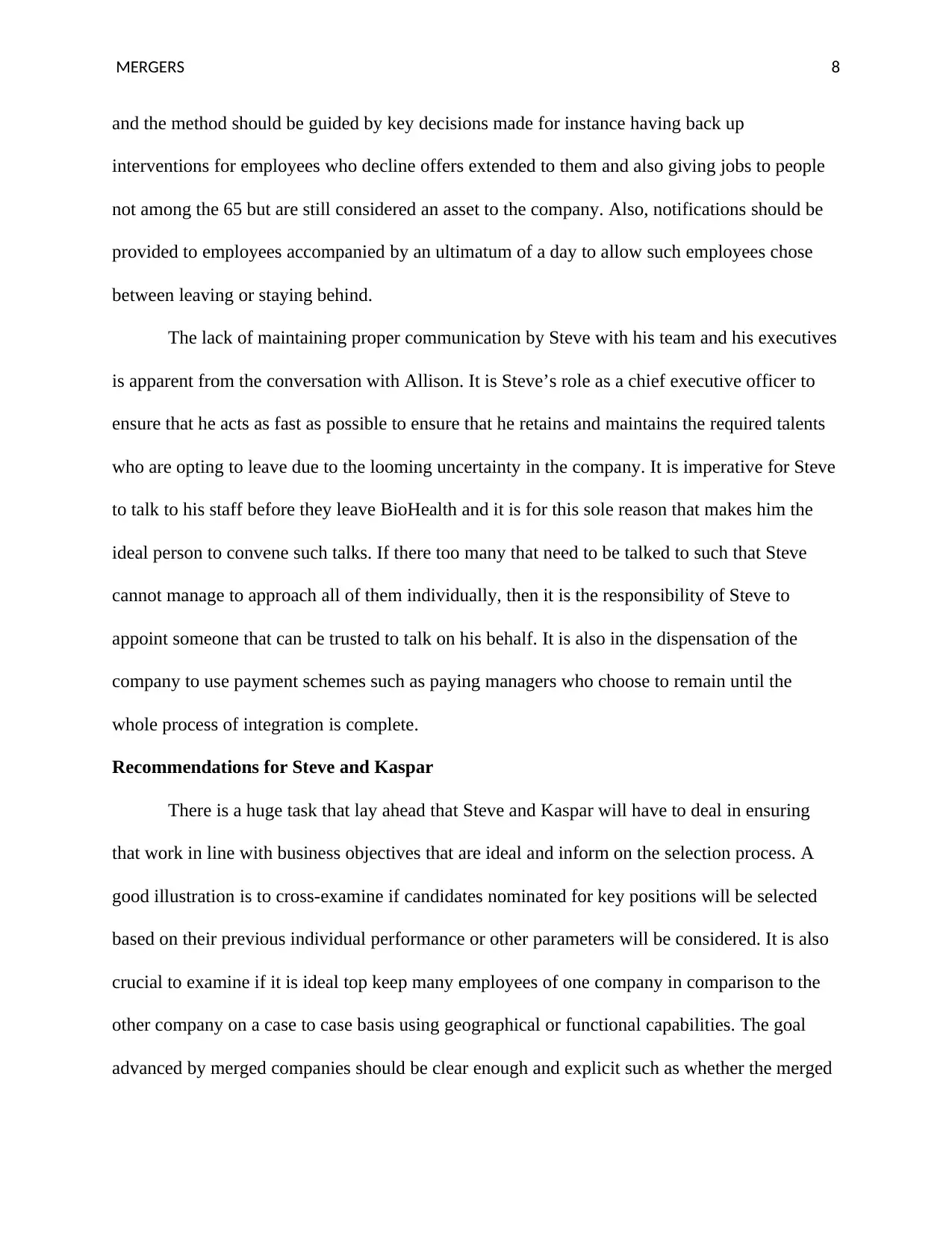
MERGERS 8
and the method should be guided by key decisions made for instance having back up
interventions for employees who decline offers extended to them and also giving jobs to people
not among the 65 but are still considered an asset to the company. Also, notifications should be
provided to employees accompanied by an ultimatum of a day to allow such employees chose
between leaving or staying behind.
The lack of maintaining proper communication by Steve with his team and his executives
is apparent from the conversation with Allison. It is Steve’s role as a chief executive officer to
ensure that he acts as fast as possible to ensure that he retains and maintains the required talents
who are opting to leave due to the looming uncertainty in the company. It is imperative for Steve
to talk to his staff before they leave BioHealth and it is for this sole reason that makes him the
ideal person to convene such talks. If there too many that need to be talked to such that Steve
cannot manage to approach all of them individually, then it is the responsibility of Steve to
appoint someone that can be trusted to talk on his behalf. It is also in the dispensation of the
company to use payment schemes such as paying managers who choose to remain until the
whole process of integration is complete.
Recommendations for Steve and Kaspar
There is a huge task that lay ahead that Steve and Kaspar will have to deal in ensuring
that work in line with business objectives that are ideal and inform on the selection process. A
good illustration is to cross-examine if candidates nominated for key positions will be selected
based on their previous individual performance or other parameters will be considered. It is also
crucial to examine if it is ideal top keep many employees of one company in comparison to the
other company on a case to case basis using geographical or functional capabilities. The goal
advanced by merged companies should be clear enough and explicit such as whether the merged
and the method should be guided by key decisions made for instance having back up
interventions for employees who decline offers extended to them and also giving jobs to people
not among the 65 but are still considered an asset to the company. Also, notifications should be
provided to employees accompanied by an ultimatum of a day to allow such employees chose
between leaving or staying behind.
The lack of maintaining proper communication by Steve with his team and his executives
is apparent from the conversation with Allison. It is Steve’s role as a chief executive officer to
ensure that he acts as fast as possible to ensure that he retains and maintains the required talents
who are opting to leave due to the looming uncertainty in the company. It is imperative for Steve
to talk to his staff before they leave BioHealth and it is for this sole reason that makes him the
ideal person to convene such talks. If there too many that need to be talked to such that Steve
cannot manage to approach all of them individually, then it is the responsibility of Steve to
appoint someone that can be trusted to talk on his behalf. It is also in the dispensation of the
company to use payment schemes such as paying managers who choose to remain until the
whole process of integration is complete.
Recommendations for Steve and Kaspar
There is a huge task that lay ahead that Steve and Kaspar will have to deal in ensuring
that work in line with business objectives that are ideal and inform on the selection process. A
good illustration is to cross-examine if candidates nominated for key positions will be selected
based on their previous individual performance or other parameters will be considered. It is also
crucial to examine if it is ideal top keep many employees of one company in comparison to the
other company on a case to case basis using geographical or functional capabilities. The goal
advanced by merged companies should be clear enough and explicit such as whether the merged
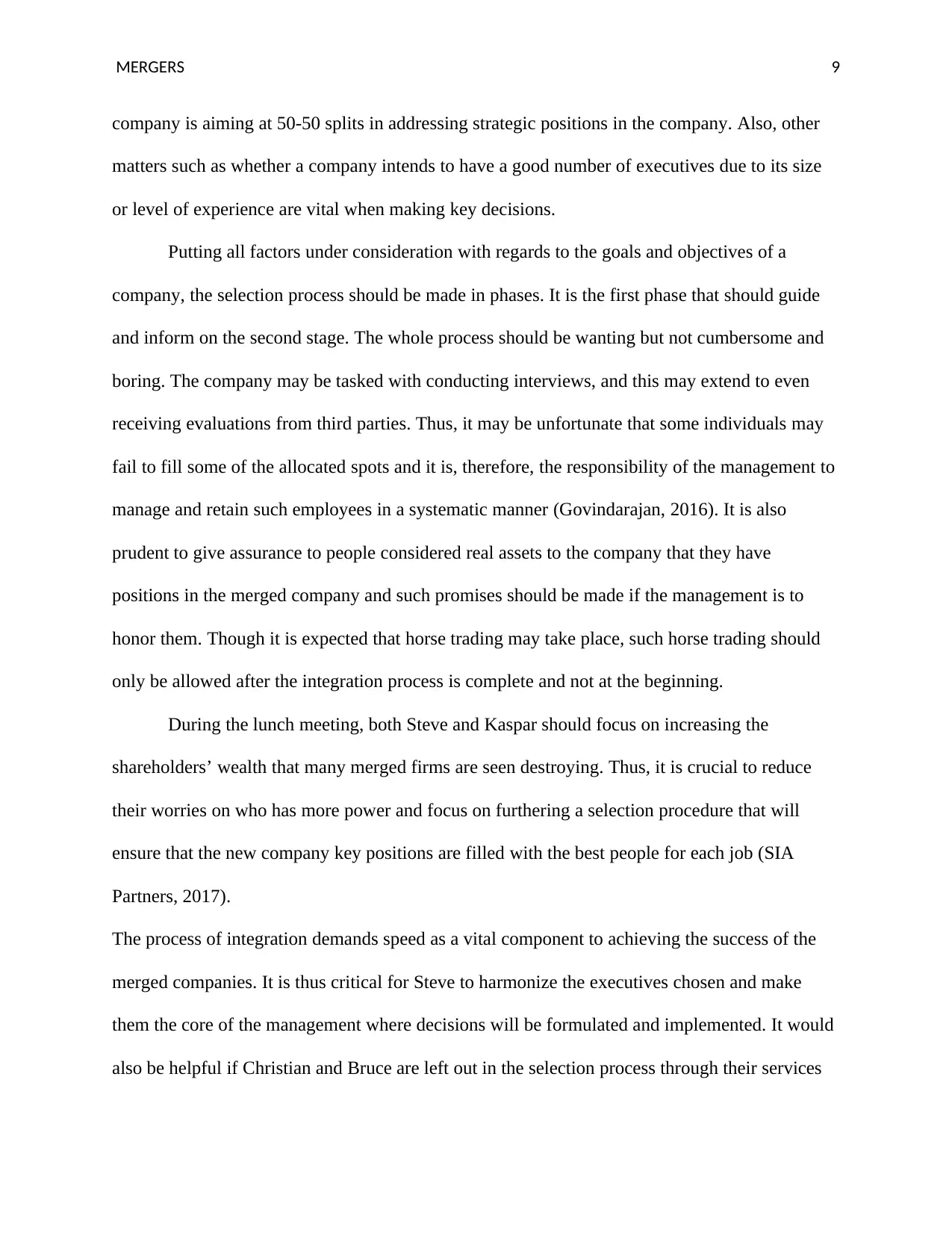
MERGERS 9
company is aiming at 50-50 splits in addressing strategic positions in the company. Also, other
matters such as whether a company intends to have a good number of executives due to its size
or level of experience are vital when making key decisions.
Putting all factors under consideration with regards to the goals and objectives of a
company, the selection process should be made in phases. It is the first phase that should guide
and inform on the second stage. The whole process should be wanting but not cumbersome and
boring. The company may be tasked with conducting interviews, and this may extend to even
receiving evaluations from third parties. Thus, it may be unfortunate that some individuals may
fail to fill some of the allocated spots and it is, therefore, the responsibility of the management to
manage and retain such employees in a systematic manner (Govindarajan, 2016). It is also
prudent to give assurance to people considered real assets to the company that they have
positions in the merged company and such promises should be made if the management is to
honor them. Though it is expected that horse trading may take place, such horse trading should
only be allowed after the integration process is complete and not at the beginning.
During the lunch meeting, both Steve and Kaspar should focus on increasing the
shareholders’ wealth that many merged firms are seen destroying. Thus, it is crucial to reduce
their worries on who has more power and focus on furthering a selection procedure that will
ensure that the new company key positions are filled with the best people for each job (SIA
Partners, 2017).
The process of integration demands speed as a vital component to achieving the success of the
merged companies. It is thus critical for Steve to harmonize the executives chosen and make
them the core of the management where decisions will be formulated and implemented. It would
also be helpful if Christian and Bruce are left out in the selection process through their services
company is aiming at 50-50 splits in addressing strategic positions in the company. Also, other
matters such as whether a company intends to have a good number of executives due to its size
or level of experience are vital when making key decisions.
Putting all factors under consideration with regards to the goals and objectives of a
company, the selection process should be made in phases. It is the first phase that should guide
and inform on the second stage. The whole process should be wanting but not cumbersome and
boring. The company may be tasked with conducting interviews, and this may extend to even
receiving evaluations from third parties. Thus, it may be unfortunate that some individuals may
fail to fill some of the allocated spots and it is, therefore, the responsibility of the management to
manage and retain such employees in a systematic manner (Govindarajan, 2016). It is also
prudent to give assurance to people considered real assets to the company that they have
positions in the merged company and such promises should be made if the management is to
honor them. Though it is expected that horse trading may take place, such horse trading should
only be allowed after the integration process is complete and not at the beginning.
During the lunch meeting, both Steve and Kaspar should focus on increasing the
shareholders’ wealth that many merged firms are seen destroying. Thus, it is crucial to reduce
their worries on who has more power and focus on furthering a selection procedure that will
ensure that the new company key positions are filled with the best people for each job (SIA
Partners, 2017).
The process of integration demands speed as a vital component to achieving the success of the
merged companies. It is thus critical for Steve to harmonize the executives chosen and make
them the core of the management where decisions will be formulated and implemented. It would
also be helpful if Christian and Bruce are left out in the selection process through their services
⊘ This is a preview!⊘
Do you want full access?
Subscribe today to unlock all pages.

Trusted by 1+ million students worldwide
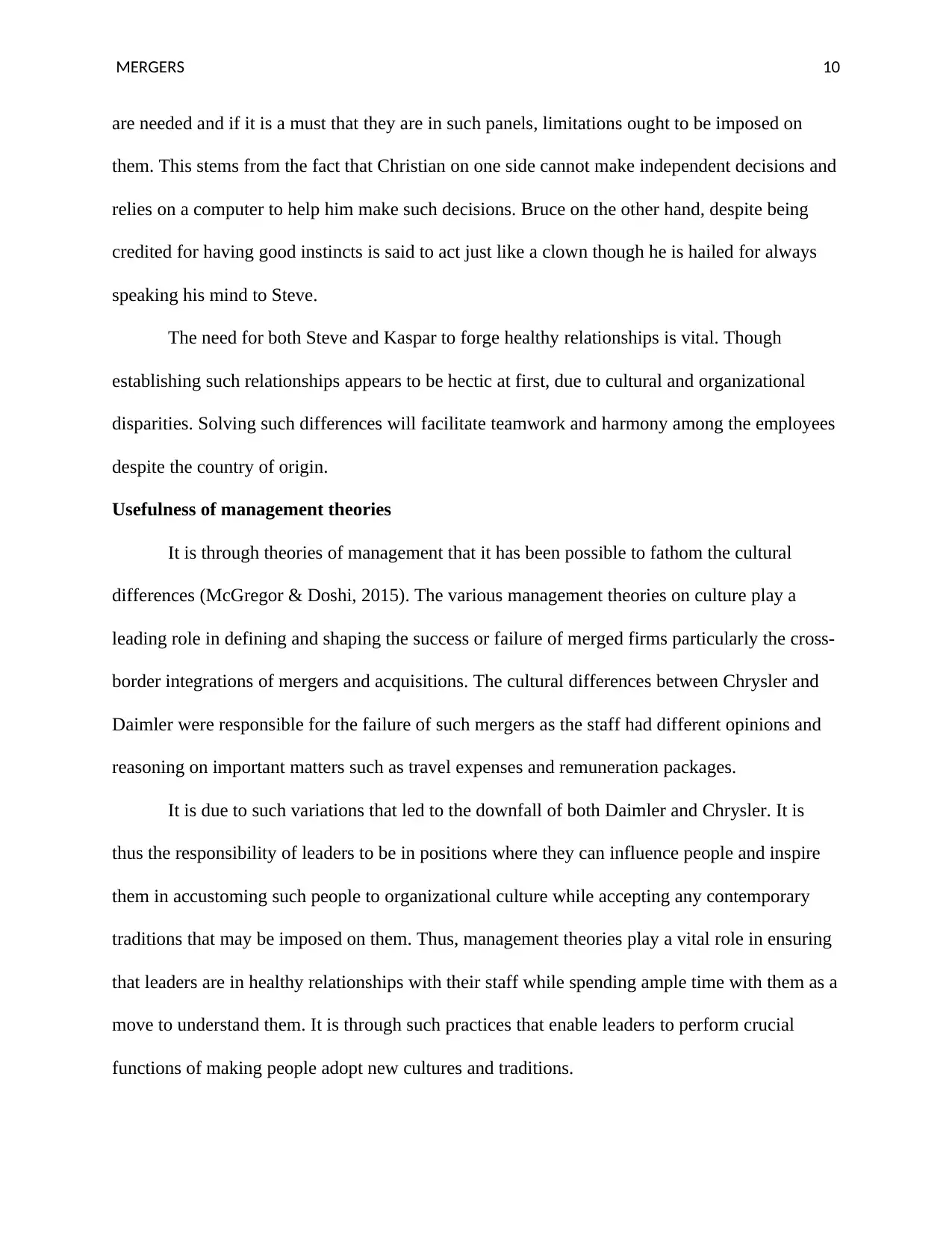
MERGERS 10
are needed and if it is a must that they are in such panels, limitations ought to be imposed on
them. This stems from the fact that Christian on one side cannot make independent decisions and
relies on a computer to help him make such decisions. Bruce on the other hand, despite being
credited for having good instincts is said to act just like a clown though he is hailed for always
speaking his mind to Steve.
The need for both Steve and Kaspar to forge healthy relationships is vital. Though
establishing such relationships appears to be hectic at first, due to cultural and organizational
disparities. Solving such differences will facilitate teamwork and harmony among the employees
despite the country of origin.
Usefulness of management theories
It is through theories of management that it has been possible to fathom the cultural
differences (McGregor & Doshi, 2015). The various management theories on culture play a
leading role in defining and shaping the success or failure of merged firms particularly the cross-
border integrations of mergers and acquisitions. The cultural differences between Chrysler and
Daimler were responsible for the failure of such mergers as the staff had different opinions and
reasoning on important matters such as travel expenses and remuneration packages.
It is due to such variations that led to the downfall of both Daimler and Chrysler. It is
thus the responsibility of leaders to be in positions where they can influence people and inspire
them in accustoming such people to organizational culture while accepting any contemporary
traditions that may be imposed on them. Thus, management theories play a vital role in ensuring
that leaders are in healthy relationships with their staff while spending ample time with them as a
move to understand them. It is through such practices that enable leaders to perform crucial
functions of making people adopt new cultures and traditions.
are needed and if it is a must that they are in such panels, limitations ought to be imposed on
them. This stems from the fact that Christian on one side cannot make independent decisions and
relies on a computer to help him make such decisions. Bruce on the other hand, despite being
credited for having good instincts is said to act just like a clown though he is hailed for always
speaking his mind to Steve.
The need for both Steve and Kaspar to forge healthy relationships is vital. Though
establishing such relationships appears to be hectic at first, due to cultural and organizational
disparities. Solving such differences will facilitate teamwork and harmony among the employees
despite the country of origin.
Usefulness of management theories
It is through theories of management that it has been possible to fathom the cultural
differences (McGregor & Doshi, 2015). The various management theories on culture play a
leading role in defining and shaping the success or failure of merged firms particularly the cross-
border integrations of mergers and acquisitions. The cultural differences between Chrysler and
Daimler were responsible for the failure of such mergers as the staff had different opinions and
reasoning on important matters such as travel expenses and remuneration packages.
It is due to such variations that led to the downfall of both Daimler and Chrysler. It is
thus the responsibility of leaders to be in positions where they can influence people and inspire
them in accustoming such people to organizational culture while accepting any contemporary
traditions that may be imposed on them. Thus, management theories play a vital role in ensuring
that leaders are in healthy relationships with their staff while spending ample time with them as a
move to understand them. It is through such practices that enable leaders to perform crucial
functions of making people adopt new cultures and traditions.
Paraphrase This Document
Need a fresh take? Get an instant paraphrase of this document with our AI Paraphraser
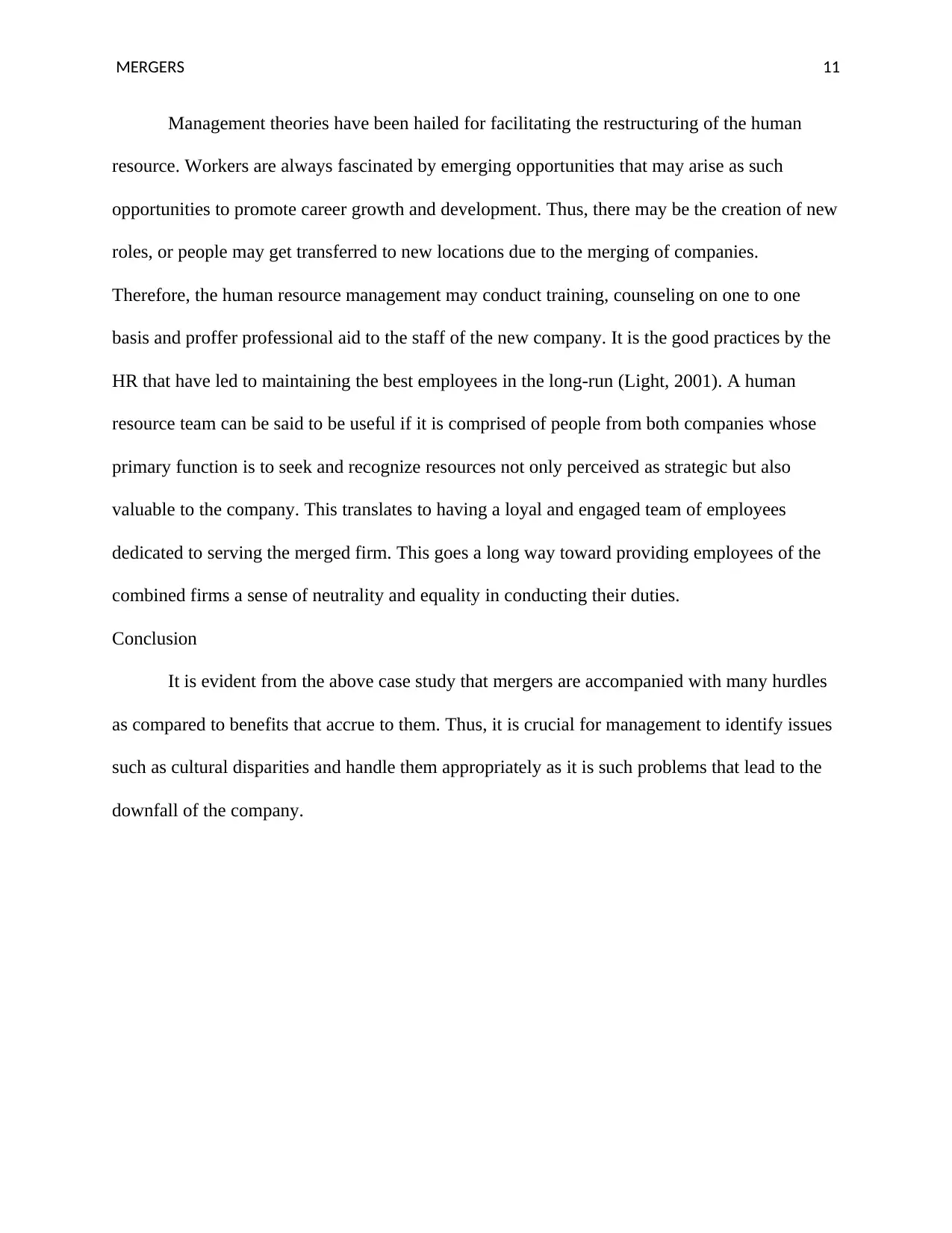
MERGERS 11
Management theories have been hailed for facilitating the restructuring of the human
resource. Workers are always fascinated by emerging opportunities that may arise as such
opportunities to promote career growth and development. Thus, there may be the creation of new
roles, or people may get transferred to new locations due to the merging of companies.
Therefore, the human resource management may conduct training, counseling on one to one
basis and proffer professional aid to the staff of the new company. It is the good practices by the
HR that have led to maintaining the best employees in the long-run (Light, 2001). A human
resource team can be said to be useful if it is comprised of people from both companies whose
primary function is to seek and recognize resources not only perceived as strategic but also
valuable to the company. This translates to having a loyal and engaged team of employees
dedicated to serving the merged firm. This goes a long way toward providing employees of the
combined firms a sense of neutrality and equality in conducting their duties.
Conclusion
It is evident from the above case study that mergers are accompanied with many hurdles
as compared to benefits that accrue to them. Thus, it is crucial for management to identify issues
such as cultural disparities and handle them appropriately as it is such problems that lead to the
downfall of the company.
Management theories have been hailed for facilitating the restructuring of the human
resource. Workers are always fascinated by emerging opportunities that may arise as such
opportunities to promote career growth and development. Thus, there may be the creation of new
roles, or people may get transferred to new locations due to the merging of companies.
Therefore, the human resource management may conduct training, counseling on one to one
basis and proffer professional aid to the staff of the new company. It is the good practices by the
HR that have led to maintaining the best employees in the long-run (Light, 2001). A human
resource team can be said to be useful if it is comprised of people from both companies whose
primary function is to seek and recognize resources not only perceived as strategic but also
valuable to the company. This translates to having a loyal and engaged team of employees
dedicated to serving the merged firm. This goes a long way toward providing employees of the
combined firms a sense of neutrality and equality in conducting their duties.
Conclusion
It is evident from the above case study that mergers are accompanied with many hurdles
as compared to benefits that accrue to them. Thus, it is crucial for management to identify issues
such as cultural disparities and handle them appropriately as it is such problems that lead to the
downfall of the company.
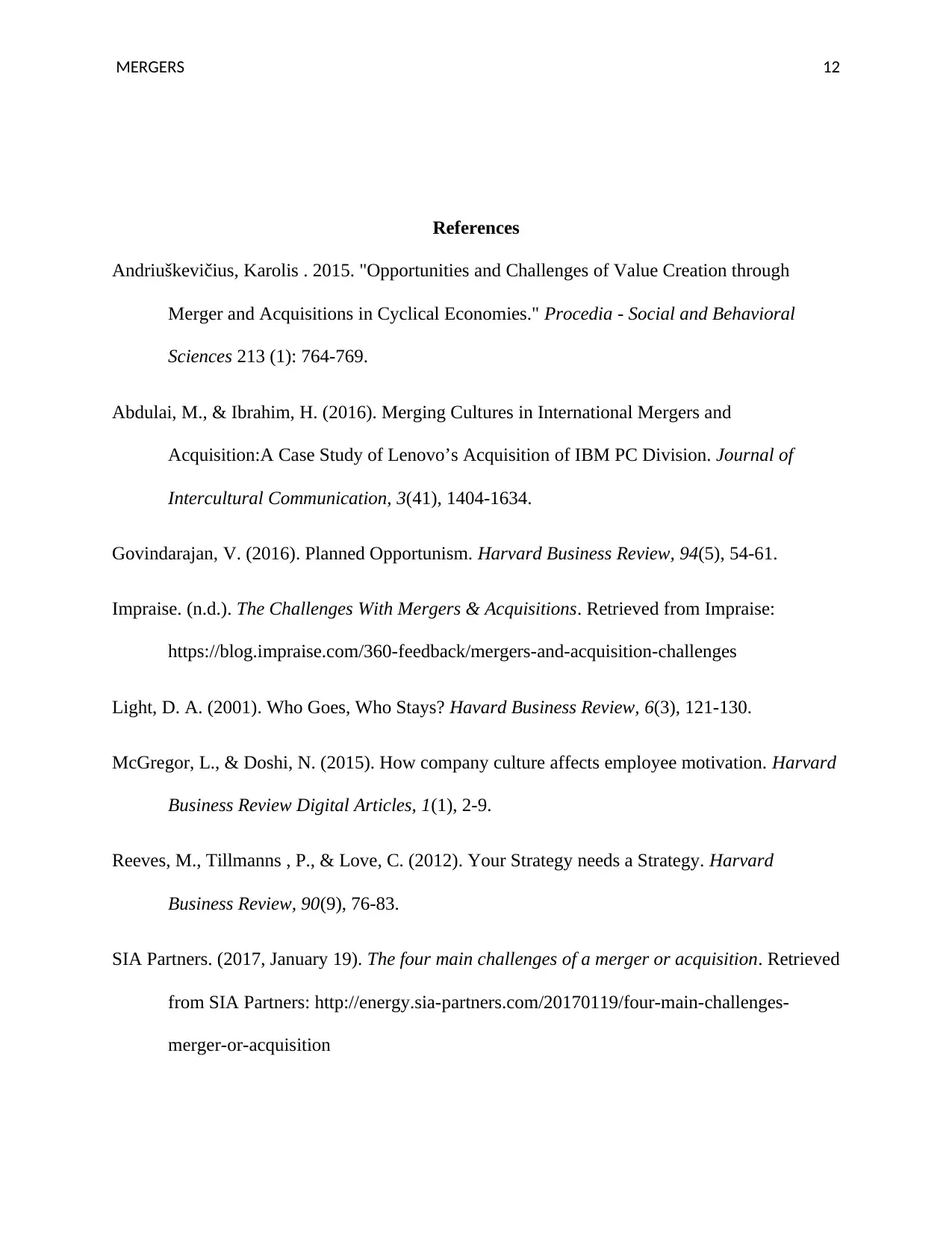
MERGERS 12
References
Andriuškevičius, Karolis . 2015. "Opportunities and Challenges of Value Creation through
Merger and Acquisitions in Cyclical Economies." Procedia - Social and Behavioral
Sciences 213 (1): 764-769.
Abdulai, M., & Ibrahim, H. (2016). Merging Cultures in International Mergers and
Acquisition:A Case Study of Lenovo’s Acquisition of IBM PC Division. Journal of
Intercultural Communication, 3(41), 1404-1634.
Govindarajan, V. (2016). Planned Opportunism. Harvard Business Review, 94(5), 54-61.
Impraise. (n.d.). The Challenges With Mergers & Acquisitions. Retrieved from Impraise:
https://blog.impraise.com/360-feedback/mergers-and-acquisition-challenges
Light, D. A. (2001). Who Goes, Who Stays? Havard Business Review, 6(3), 121-130.
McGregor, L., & Doshi, N. (2015). How company culture affects employee motivation. Harvard
Business Review Digital Articles, 1(1), 2-9.
Reeves, M., Tillmanns , P., & Love, C. (2012). Your Strategy needs a Strategy. Harvard
Business Review, 90(9), 76-83.
SIA Partners. (2017, January 19). The four main challenges of a merger or acquisition. Retrieved
from SIA Partners: http://energy.sia-partners.com/20170119/four-main-challenges-
merger-or-acquisition
References
Andriuškevičius, Karolis . 2015. "Opportunities and Challenges of Value Creation through
Merger and Acquisitions in Cyclical Economies." Procedia - Social and Behavioral
Sciences 213 (1): 764-769.
Abdulai, M., & Ibrahim, H. (2016). Merging Cultures in International Mergers and
Acquisition:A Case Study of Lenovo’s Acquisition of IBM PC Division. Journal of
Intercultural Communication, 3(41), 1404-1634.
Govindarajan, V. (2016). Planned Opportunism. Harvard Business Review, 94(5), 54-61.
Impraise. (n.d.). The Challenges With Mergers & Acquisitions. Retrieved from Impraise:
https://blog.impraise.com/360-feedback/mergers-and-acquisition-challenges
Light, D. A. (2001). Who Goes, Who Stays? Havard Business Review, 6(3), 121-130.
McGregor, L., & Doshi, N. (2015). How company culture affects employee motivation. Harvard
Business Review Digital Articles, 1(1), 2-9.
Reeves, M., Tillmanns , P., & Love, C. (2012). Your Strategy needs a Strategy. Harvard
Business Review, 90(9), 76-83.
SIA Partners. (2017, January 19). The four main challenges of a merger or acquisition. Retrieved
from SIA Partners: http://energy.sia-partners.com/20170119/four-main-challenges-
merger-or-acquisition
⊘ This is a preview!⊘
Do you want full access?
Subscribe today to unlock all pages.

Trusted by 1+ million students worldwide
1 out of 13
Related Documents
Your All-in-One AI-Powered Toolkit for Academic Success.
+13062052269
info@desklib.com
Available 24*7 on WhatsApp / Email
![[object Object]](/_next/static/media/star-bottom.7253800d.svg)
Unlock your academic potential
Copyright © 2020–2025 A2Z Services. All Rights Reserved. Developed and managed by ZUCOL.




